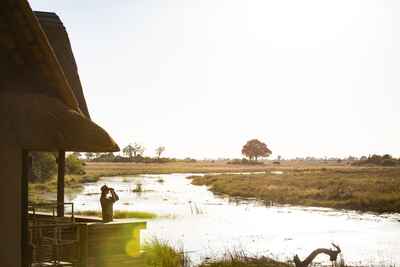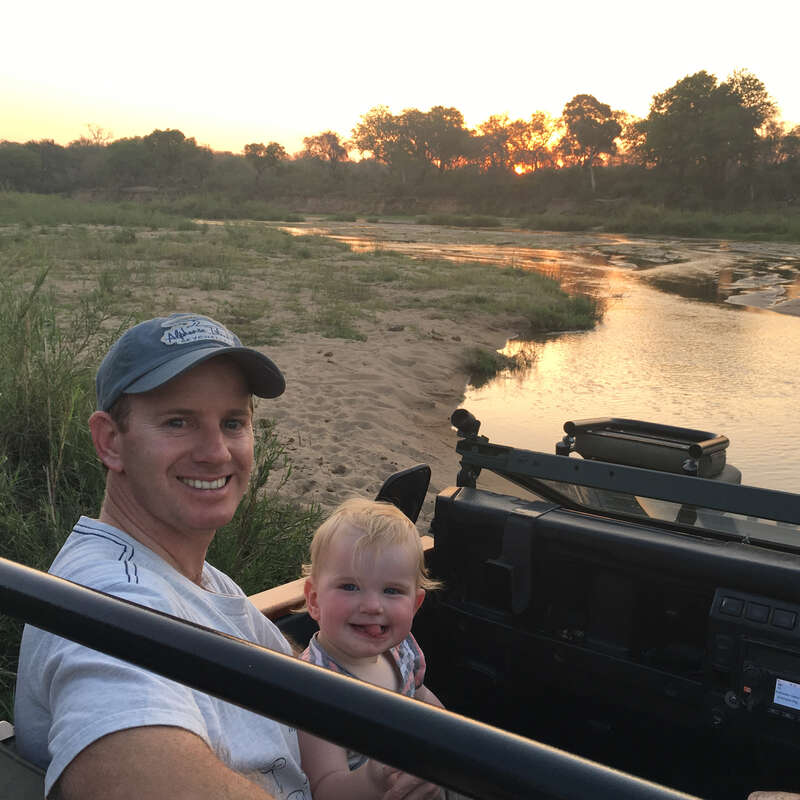About Kings Pool
High standards of design, service, food and guiding: these are the hallmarks of King’s Pool.
It's a winning combination, with guests at the forefront of every aspect of this luxurious camp, scenically set on the edge of an oxbow lake.
If you’d prefer your lunch to be served later than the norm, that can be arranged. The choice of drinks stocked in your minibar is yours; so is the decision on private or communal dining.
Enthusiastic and knowledgeable guides take that flexibility to the next level. An animal’s alarm call could trigger an immediate search, guests on high alert in their game-drive vehicle as the source of the alarm is sought.
But it’s by no means all adrenalin drives. Just settle down in camp – on the large viewing deck or your own veranda – and watch out for elephants crossing the Linyanti River. Listen to the sounds of hippos in the lagoon, or perhaps a porcupine snuffling around after dark.
In the middle of the year, this is a watery wilderness that invites exploration on the classy Queen Silvia barge. As the waters recede, the sunken hide comes into its own – and game drives take on a new edge.
For all the creature comforts at King’s Pool – the four-poster beds, the leather chairs and eclectic décor – this is what really matters.
Our view
King's Pool remains luxurious, with faultless service and very good food. If you want a high-quality safari camp where you can experience the riverine environment that's typical of the Chobe and Linyanti riverfronts, it's certainly a good option.
When it's dry, the game viewing can be good, but we would be hesitant to explore this area in the green or shoulder season due to the dense mopane forests south of the camp.
Accommodation
8 suites
Children
Best for ages 12+
Open
All year
Activities

4WD Safari

Birdwatching

Boat trip

Fishing

Guided walking safari

Helicopter

Mokoro

Night drive

Private activities
Traveller reviews of Kings Pool
9 real, un-edited reviews from Expert Africa's travellers.
Arrived 20 Sep 2022, 4 nights
"Kings Pool review"
Overall rating: Excellent
Arrived 28 Apr 2022, 3 nights
"Kings Pool review"
Overall rating: Excellent
Arrived 10 Oct 2017, 3 nights
"Kings Pool review"
Overall rating: Average
Arrived 16 Nov 2015, 3 nights
"Truly stunning camp"
Overall rating: Excellent
Arrived 21 Aug 2008, 2 nights
"Not on my return list"
Overall rating: Average
Arrived 21 Aug 2008, 2 nights
"Disappointing game"
Overall rating: Average
Arrived 12 Aug 2008, 3 nights
"The horrors of expensive King's Pool"
Overall rating: Poor
Arrived 29 May 2008, 2 nights
"King's Pool review"
Overall rating: Good
Arrived 24 Oct 2007, 2 nights
"Beautiful lodge"
Overall rating: Excellent
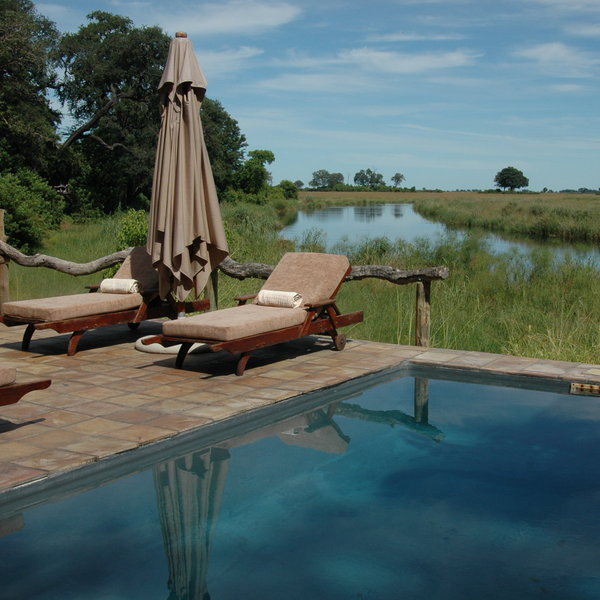
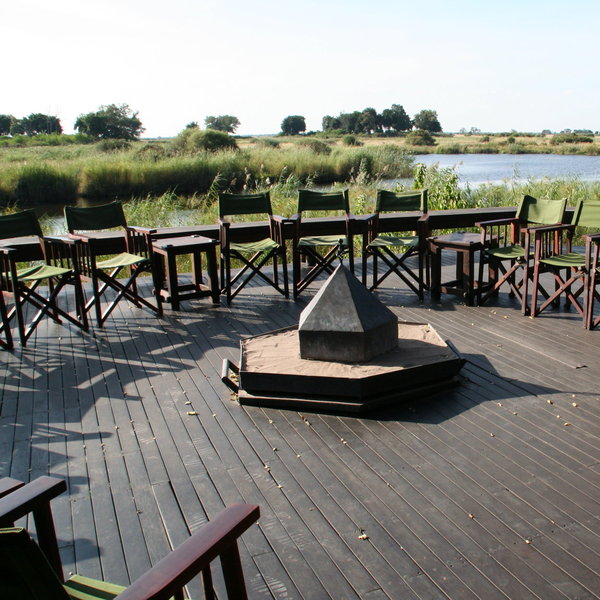
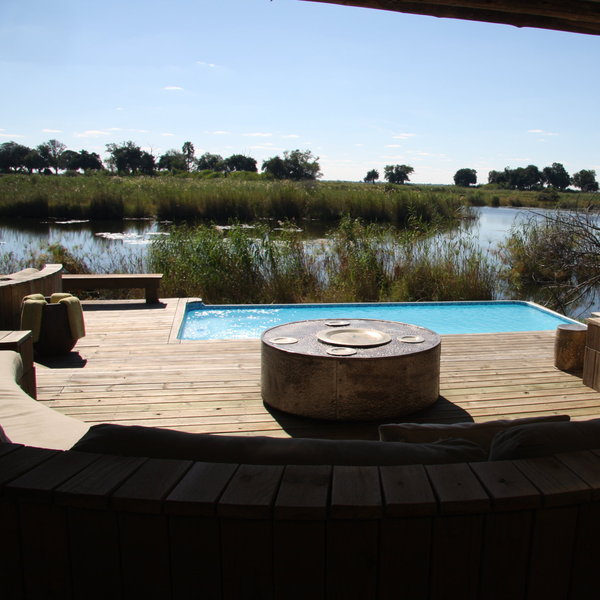
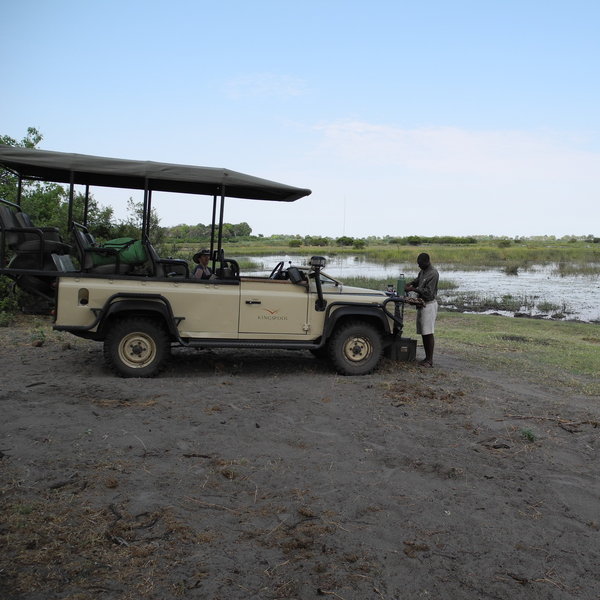
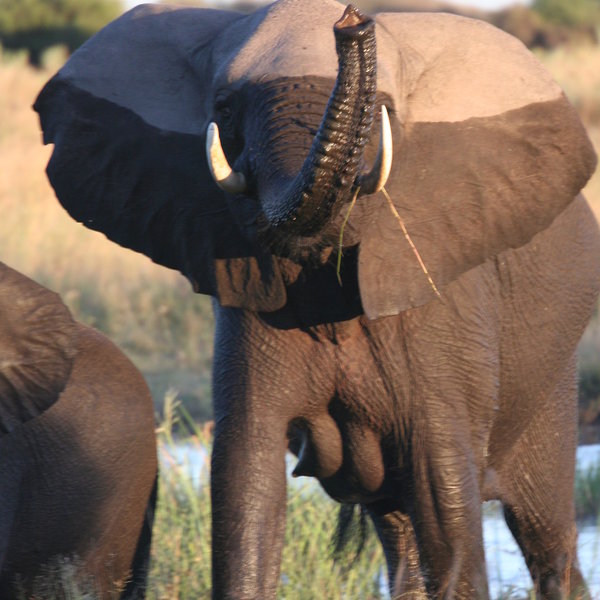
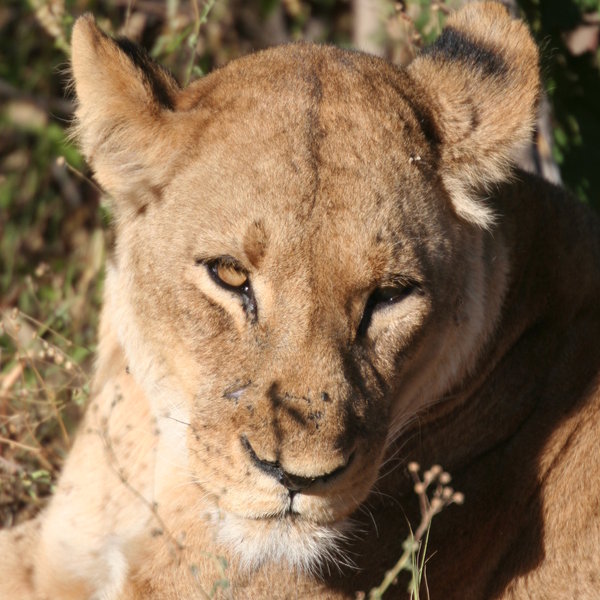
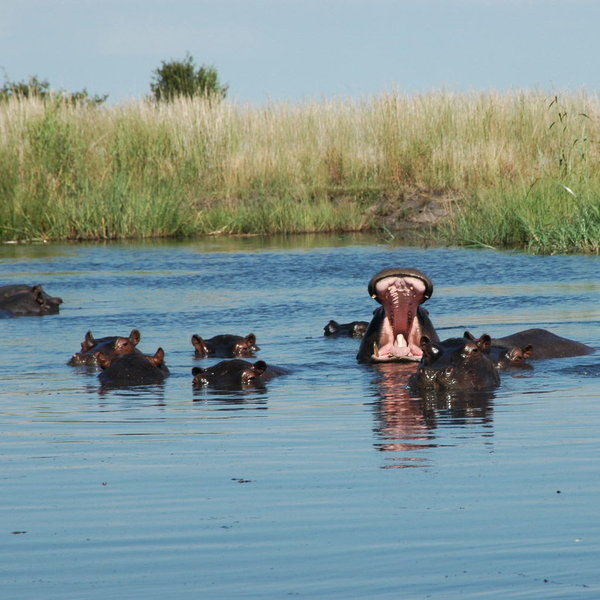
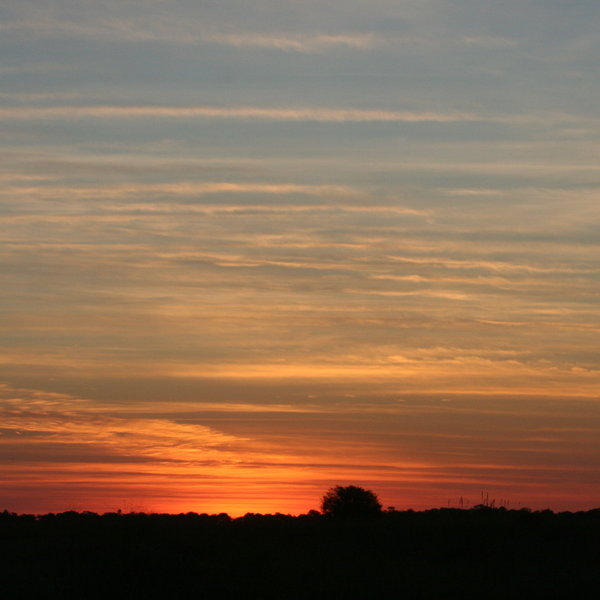
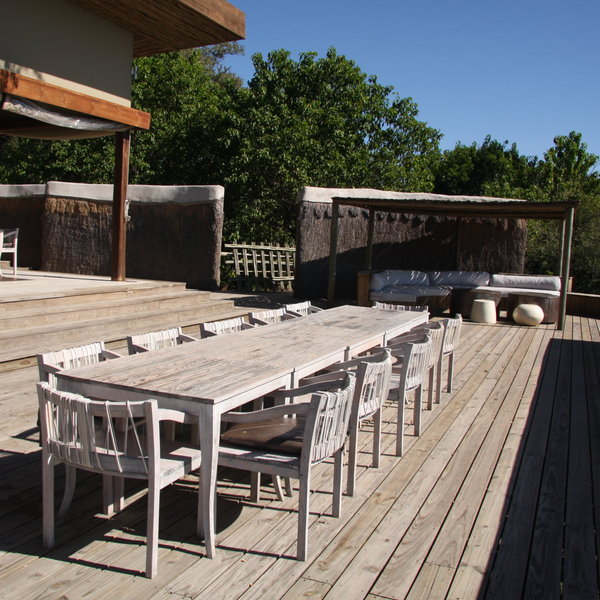
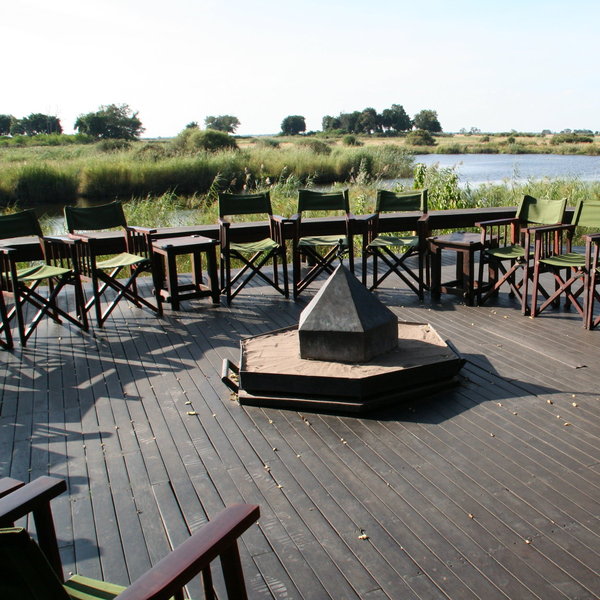
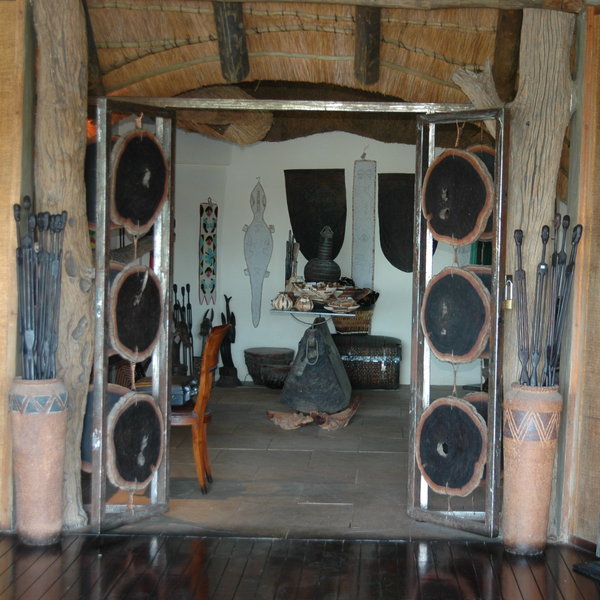
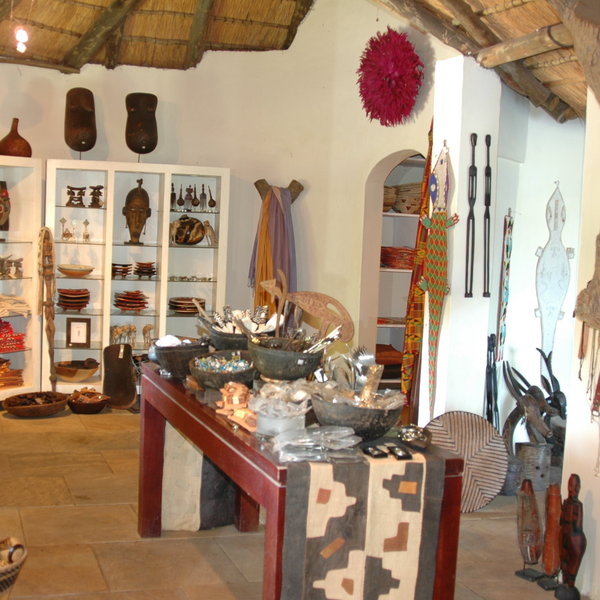
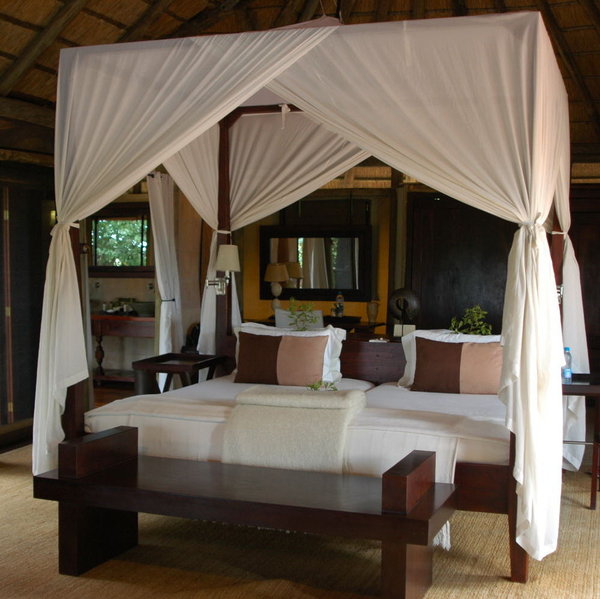
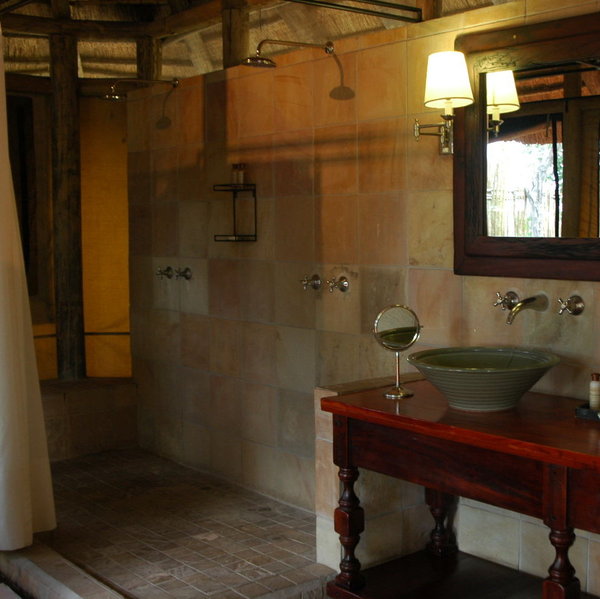
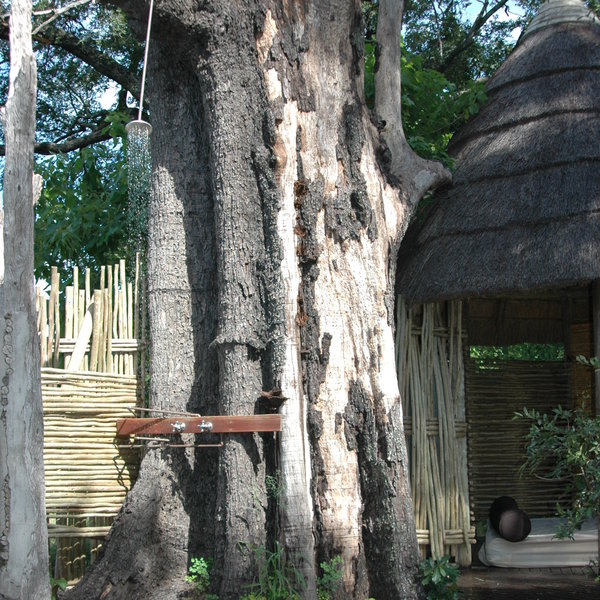
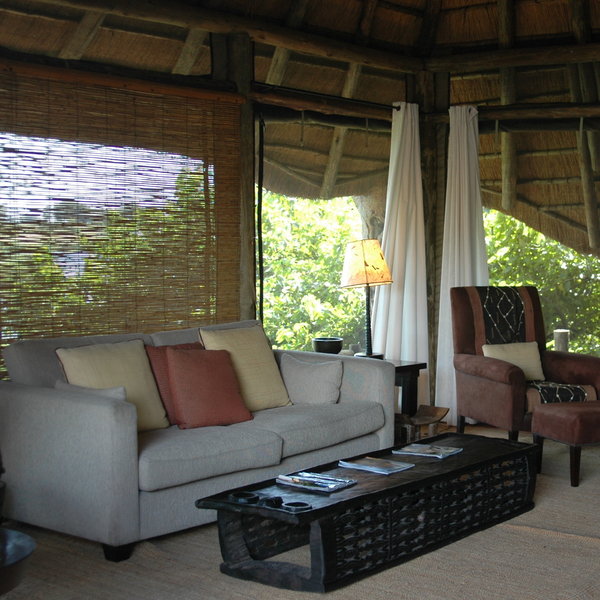
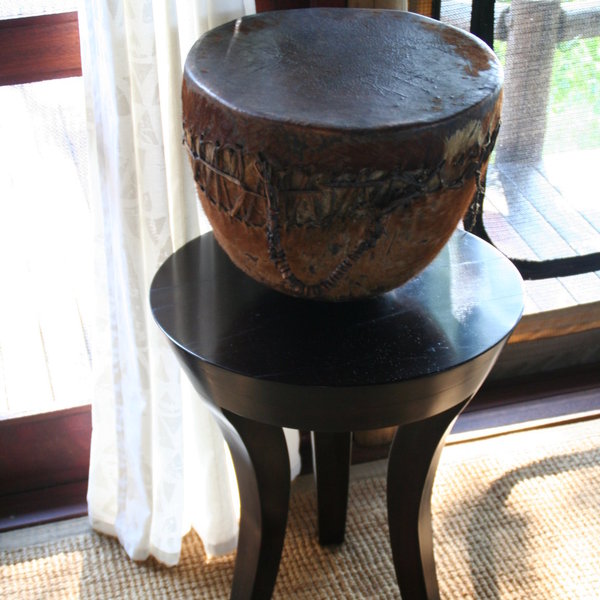
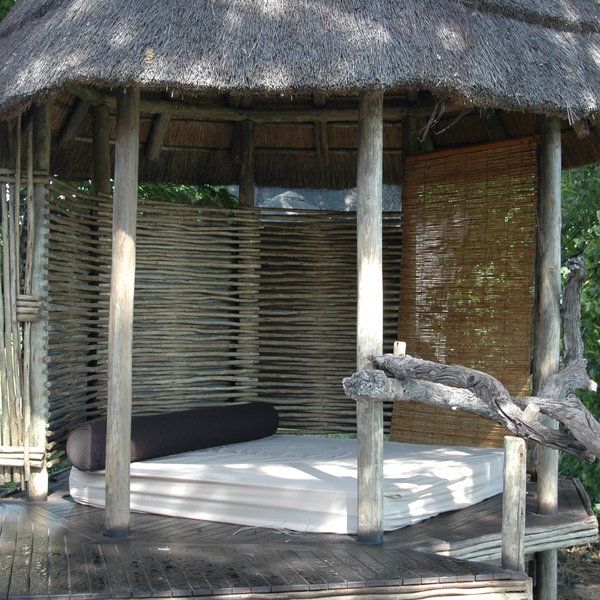
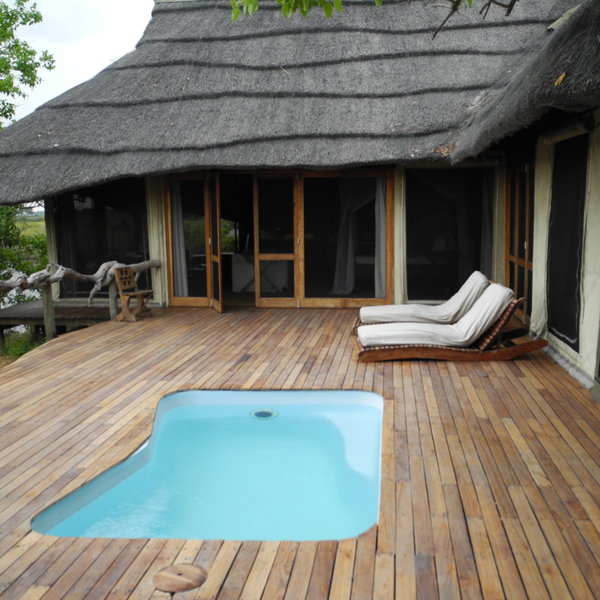
Expert Africa's gallery
When we travel we take lots of photos ourselves to give you a real and un-edited view of the safaris. See our 33 pictures of Kings Pool to get the candid view.
View galleryKings Pool: Our full report
Set within Botswana’s private Linyanti Reserve, King's Pool Camp overlooks a picturesque oxbow lagoon.
The environment, along the Linyanti River, is similar to that of Botswana’s Chobe Riverfront area – seasonal floodplains near the river, an adjacent band of riverine forest, and then dense (mostly mopane) forests stretching away south. Following a significant makeover in 2019, King’s Pool has retained its original high standards, with well-trained staff and considerable attention to detail.
King’s Pool is one of four permanent camps within the 1,250km² reserve (the others being Duma Tau, Little Duma Tau and Savuti Camp).
The camp has eight tented suites which are built on wooden decks along the edge of the water, three to one side of the main area, five to the other. Although the walls are largely of canvas, the overall feel of the suites is surprisingly substantial.
Each suite has a large outside area with sunloungers and a sala, as well as an open-air shower. Shaded by magnificent jackalberry and leadwood trees, this is a great place for a siesta.
Ornate wooden doors open into spacious rooms with high thatched roofs. Four-poster-style beds are the focus of the bedroom area, with views out over the lagoon. Note that some beds can be made up as twins, but due to the four-poster design they cannot be pulled apart.
Each suite is also furnished with a couple of comfortable armchairs and matching foot stools, as well as a writing desk with a charging station, a dressing table and a large wardrobe. We thought that the “mini gym” provided in each wardrobe was a great idea – there is plenty of room on the deck or inside for those wishing to use the weights or yoga mat supplied.
In addition, there is a minibar in each suite, which the staff will gladly stock with your preferred drinks. There are also tea- and coffee-making facilities and a selection of sweet and savoury snacks.
To one side of the suite, the bathroom leads out onto the deck, with a flushing toilet in a separate room to the other side. Tiled walls make the bathroom feel more suited to a modern hotel than a safari camp, and although there is a curtain across the entrance, privacy is limited. That said, the amenities are very good: twin handbasins, double indoor showers with large “rain-shower” heads, and an outdoor shower too. Africology toiletries are provided, along with dressing gowns and slippers and even a hairdryer.
With two en-suite interleading rooms, the family suite also boasts a small private plunge pool.
Raised wooden walkways connect the suites to the main building: a warm, thatched structure that looks out across the water – and the reasonably frequent spectacle of elephants crossing the Linyanti River – that tends to draw visitors straight through to the large viewing deck. On our most recent visit, in September 2024, at least a dozen hippos could be seen basking on the island in the lagoon, and we were woken during the night to a porcupine snuffling around outside our room.
While there is a more formal covered lounge area, eclectically adorned with leather cushions and an array of traditional artwork, the two sunken, semi-circular seating areas overlooking the lagoon are understandably popular and well-utilised. This is an especially pleasant area in the evening when a central firepit provides a lovely atmosphere and – sometimes – much-needed warmth. There is a classy covered dining area too, but if the weather is fine, à la carte meals are usually served al fresco. A well-stocked curio shop and an infinity plunge pool complete the picture.
Activities at King's Pool include both day and night 4WD game drives and, when water levels permit (around April to August), boat trips on the double-decker Queen Silvia through the nearby waterways. On our last visit, in September, the water level in the main river channel was not high enough for this excursion.
Wildlife sightings in the Linyanti area are usually at their best when it's dry, from around June through to October. At their peak, the herds of elephants and buffalos can number hundreds or even thousands. In addition to some lovely sightings of elephant enjoying the riverfront environment during our stay, we were surprised to have our sunset drinks interrupted by the loud alarm call of a kudu. Our guide enthusiastically took us in search of the reason for the kudu’s concern, to be rewarded with the sight of the dominant male leopard lying on a termite mound.
About ten minutes' drive from camp is a sunken hide where you can spend time observing the animals that come down to drink. It’s a popular spot during the afternoon siesta period, and is usually most interesting during the dry season, from late July onwards.
There is also a bird hide at the camp itself. The birding in the area is really varied, with the Linyanti Reserve designated an important bird area (or IBA: a globally important habitat for the conservation of bird populations). In addition to many Okavango specials, such as the slaty egret and wattled crane, you may spot a good number of dry area species, as well as several raptors. On a previous visit, we were fortunate to see a beautiful colony of carmine bee-eaters, their crimson wings catching the sunlight with each flight. These birds are summer migrants to the area, typically arriving in September and departing in late November.
Thanks to King’s Pool’s focus on luxury the staff have all been trained to a very high standard which continues to be reflected in the service that we experienced.
Activities
4WD Safari
Birdwatching
Boat trip
Fishing
Guided walking safari
Helicopter
Mokoro
Night drive
Private activities
Families & children
- Attitude towards children
- Children over the age of 12 years are welcome at King's Pool. The camp may accept children between the ages of 6 and 12 years old, but private activities must be booked and this will be at an extra cost. Children younger than six may be accepted by special arrangement, but only if the entire camp is reserved for exclusive use.
- Property’s age restrictions
- Minimum age 12 (but see notes above). Children are allowed on boat trips from the age of six years, but sleep-outs and walking only from the age of 13 years.
- Special activities & services
- There are no special activities or services.
- Equipment
- The family suite at King’s Pool has two interleading en-suite rooms, and a private plunge pool. It would work well for a family of two adults and two children.
- Generally recommended for children
- Although there is an element of flexibility at King’s Pool, we don't consider that the style of the camp would make families with young children feel particularly welcome. Thus we'd recommend it only for families with more mature children over the age of 12 years.
- Notes
- King's Pool is unfenced, and dangerous animals, including leopard and hippos, are known to move regularly through camp. The walkways and suites are all raised off the ground. The pools are unfenced and the main pool is in close proximity to the river. Children must be under the constant supervision of their parents or guardians.
Food & drink
- Usual board basis
- Full Board & Activities
- Food quality
- King's Pool is generally more adaptable to the needs of individual travellers than most traditional camps, including the option to choose individual tables, and reasonably flexible mealtimes.
On our last visit, in September 2024, as on previous occasions, the standard of food was very good, with an extensive variety of dishes that were elegantly presented.
A light breakfast is laid out before your morning activity, with a selection of cereals, fruit, yoghurt, muffins, croissants, smoked salmon, cheeses, and even a cooked option if you wish.
Brunch is usually available from around 11.00am, although some guests prefer to eat a little later. Most recently, we enjoyed breakfast out in the bush, but on a previous visit we sat down to a fresh beetroot soup, followed by a very succulent beef fillet with roasted tomatoes and potato wedges, polished off by sorbet or ice cream for dessert.
Afternoon tea, served just before heading out on the afternoon activity, is usually a treat! In addition to freshly baked cakes and savoury snacks such as spicy fish tacos and chicken risotto balls, there is often the option of a freshly made smoothie. We also enjoyed an afternoon pick-me-up from the espresso pod machine.
More often than not, dinner at King's Pool is a plated service with three options per course. We tucked into a starter of smoked trout paté, followed by tender venison fillet with a rosemary and red-wine jus, served
with roast potatoes and baby carrots. Dessert was a rich sticky ginger pudding. - Dining style
- Individual Tables
- Dining locations
- Indoor and Outdoor Dining
- Further dining info, including room service
- There is no room service, but the suites do have minibar fridges, which the camp will gladly stock with requested drinks.
- Drinks included
- Bottled water, soft drinks, local beers and spirits and a selection of (usually) South African red and white wines are included. Champagne and imported wines and spirits will cost extra. The camp has a better-than-average stocked bar, but can order in special requests if advance notice is given.
Guests are usually given a water bottle on arrival, which they are encouraged to top up from the filtered supply in the camp's main area. Each room is also provided with glasses and a flask of filtered drinking water. We don't recommend that travellers drink from the tap.
Our travellers’ wildlife sightings from Kings Pool
Since mid-2018, many of our travellers who stayed at Kings Pool have kindly recorded their wildlife sightings and shared them with us. The results are below. Click an animal to see more, and here to see more on our methodology.

100% success

100% success

100% success

100% success

100% success

100% success

50% success

50% success

0% success

0% success

0% success

0% success

0% success

0% success

0% success

0% success
Getting there
- Location
- Kwando-Linyanti area, Botswana
- Ideal length of stay
- Three nights is wise here – even if travellers pressed for time may stay only for two. In many ways King’s Pool is best combined with Wilderness Safaris' other top-end camps in Botswana: Vumbura Plains, Jao Camp and Mombo.
- Directions
- Access is by light aircraft transfer to Chobe airstrip, and then a 4WD drive of approximately 45 minutes to King’s Pool.
- Accessible by
- Fly-and-Transfer
Special interests
- Family safaris
- King's Pool has a family suite consisting of two en-suite interleading rooms and a private plunge pool. It would best suit families on safari in Botswana with children aged over 12; those with younger children have to book a private vehicle.
- See ideas for Family safaris in Botswana
- Luxury safaris
- Ornate wooden doors, vast rooms, four-poster beds, private decks and an open-air shower are only a few of Kings Pool’s luxurious fittings. Add hard-to-fault service, excellent guiding and very good food, thus the makings of a luxury safari.
- See ideas for Luxury safaris in Botswana
Sustainability
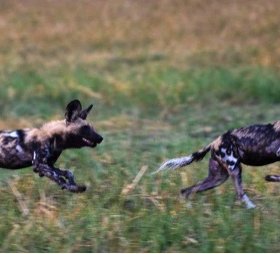
Protecting Africa’s endangered predators
Feared by many for its ruthless hunting style, but highly intelligent and with great paternal instincts, the African wild dog makes for a fascinating sight, admired by many researchers. However, the packs which would once roam the African wilderness at will are now under serious threat and have become the second most endangered African carnivore (the first being the Ethiopian wolf), suffering a substantial decline– both in numbers and in the areas that they historically occurred.
Today only a population of around 6,500 individuals has survived – inhabiting mostly isolated areas of southern Africa. Some factors which contributed to this significant drop include habitat loss and fragmentation, human persecution and conflict, diseases such as rabies, getting caught up in wire snares, loss of suitable prey and competition with other carnivores like lion and spotted hyaena.
Conservation and breeding programmes were implemented in an attempt to halt the decline in wild dog numbers. The team at King’s Pool works closely with local government bodies and the Wilderness Safaris Trust to ensure the conservation of wildlife in the area.
Recently, a wild dog den site was found close to the camp. Ever since, camp guides and the environmental team have been monitoring the newly-discovered site and making efforts to protect it. They first closed the site to protect the pups and avoided driving in a straight line to minimise the risk of other predators following them. Staff members are now using a winding and roundabout track leading to and from the area, adding a 20-metre border all around.
See more great sustainability projects in Botswana
Communications
- Power supply notes
- There's a generator for back up. Each suite has a number of plug sockets for charging batteries with a range of the more common adaptors.
- Communications
- There is WiFi in the rooms. Some cellphones with roaming may pick up reception here, as King's Pool is very near the Namibian border and cellphone network.
- TV & radio
- There is no TV or radio.
- Water supply
- Borehole
- Water supply notes
- The water is filtered through reverse osmosis.
All the suites have plumbed hot and cold running water and flush toilets
Health & safety
- Malarial protection recommended
- Yes
- Medical care
- King's Pool Camp's managers are first-aid trained, and a first-aid kit is kept on site. There is a nurse in Maun who is on call and can be contacted by radio 24 hours a day. In the event of an emergency, guests can be flown out to the nearest doctor in Maun. Please note that it is only possible to fly out of camp during daylight hours as the bush airstrips do not have any lighting at night.
- Dangerous animals
- High Risk
- Security measures
- Air horns are provided in the suites to alert attention in case of emergency. There are raised walkways between the main area and the suites, but guests are escorted to and from their suites after dark.
- Fire safety
- Fire extinguishers are placed on the verandas of all suites and in the main area.
Useful info
- Disabled access
- On Request
- Laundry facilities
- A full laundry service is included and, wherever possible, items ill be returned to guests on the same day.
- Money
- All suites are equipped with small electronic safes. There are no money-exchange facilities.
- Accepted payment on location
- Mastercard and Visa cards are accepted; Diners and Amex are not. Cash payments may be made in South African rand, GB sterling, US dollars, euros and Botswana pula.
Plan and book your trip with Expert Africa
All of our trips are tailor-made, so we'll always adapt them to suit you. Talk to an Expert and let us plan and arrange your perfect trip.

Talk to an Expert
Call or email us now! We’ll match you with the Specialist in our team who is best suited to help you. Then together we can start planning your trip.

Set up your itinerary
Based on our experience and your ideas, your specialist will create a detailed, costed itinerary. We’ll refine it together, until we have a trip that you’re perfectly happy with.

Prepare for your trip
The same Specialist will make the seamless arrangements for your trip, send you detailed travel documents, and be available to answer any questions before you depart.

Travel with peace of mind
After you set off, you’ll be cared for by our partners in Africa, most of whom have worked with Expert Africa for decades. And if you ever need us urgently, we’re available 24/7.

When you return
We love to learn about your trip, and so will always be grateful if you’ve the time to give feedback to your Specialist when you return.
Kings Pool's location
Look closer at the environment and surroundings of Kings Pool.
Excursions from Kings Pool
Optional extra day-trips and excursions possible whilst you're staying at Kings Pool. Talk to us: these are usually best arranged before you go.
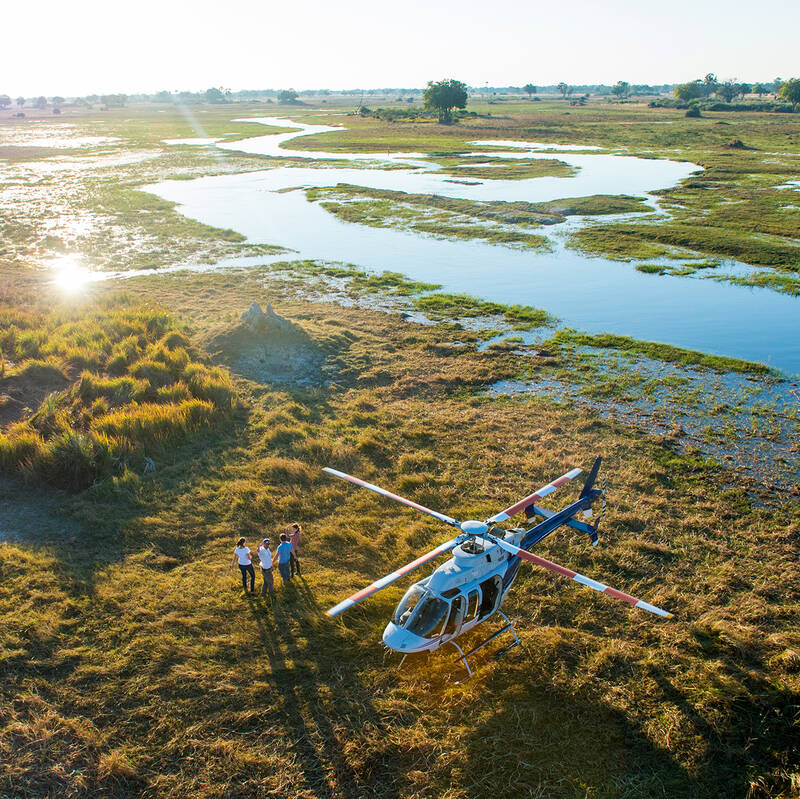
Helicopter Flight - Botswana
Various: from 30 minutes to half a day.
Low-flying, agile and offering superb views, helicopters are an ideal way to move around the Okavango Delta.You can use them instead of fixed-wing inter-lodge transfers or as an addition to other wildlife watching activities, and of course, helicopters can hover to allow that perfect pic, whereas fixed-wings can’t.
More about Helicopter FlightOther lodges in Kwando-Linyanti area
Alternative places to stay in this same area.
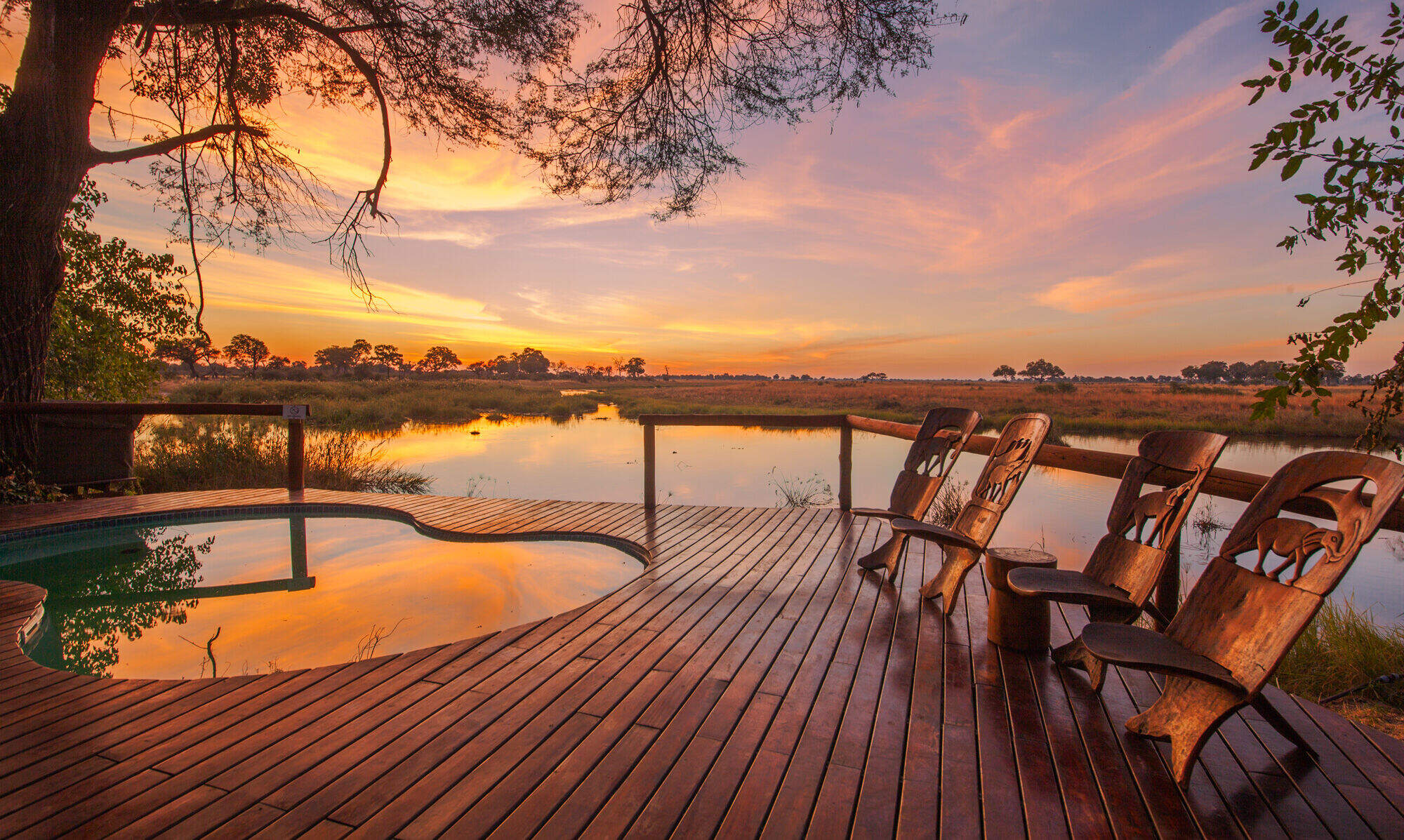
Lagoon Camp
Within the vast Kwando Reserve, renowned for its wild dogs, Lagoon Camp offers excellent game viewing that focuses on predators.
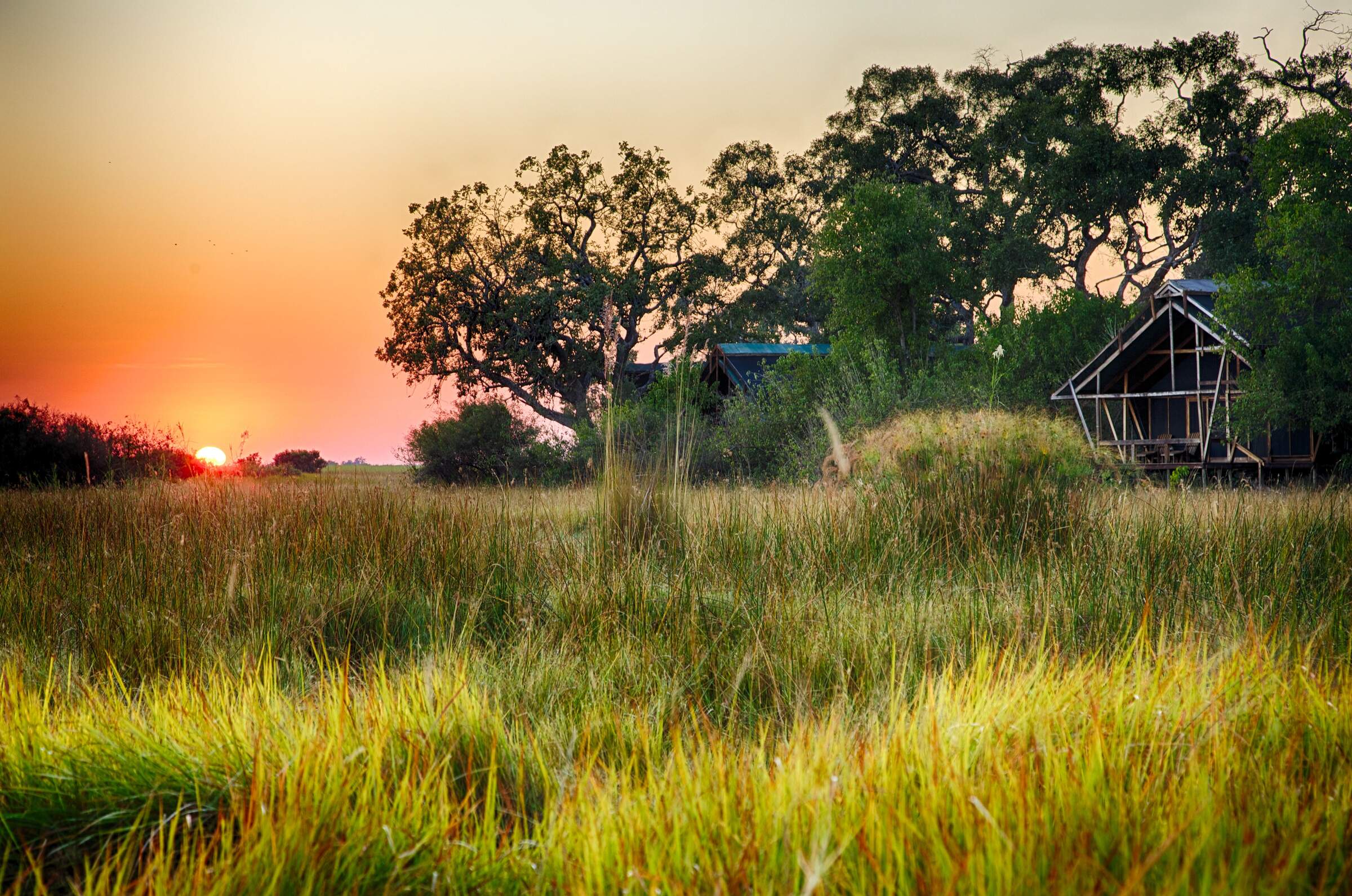
Lebala Camp
With enthusiastic guides and trackers, Lebala – in a vast private reserve – is particularly well-placed for seeking wild dogs.
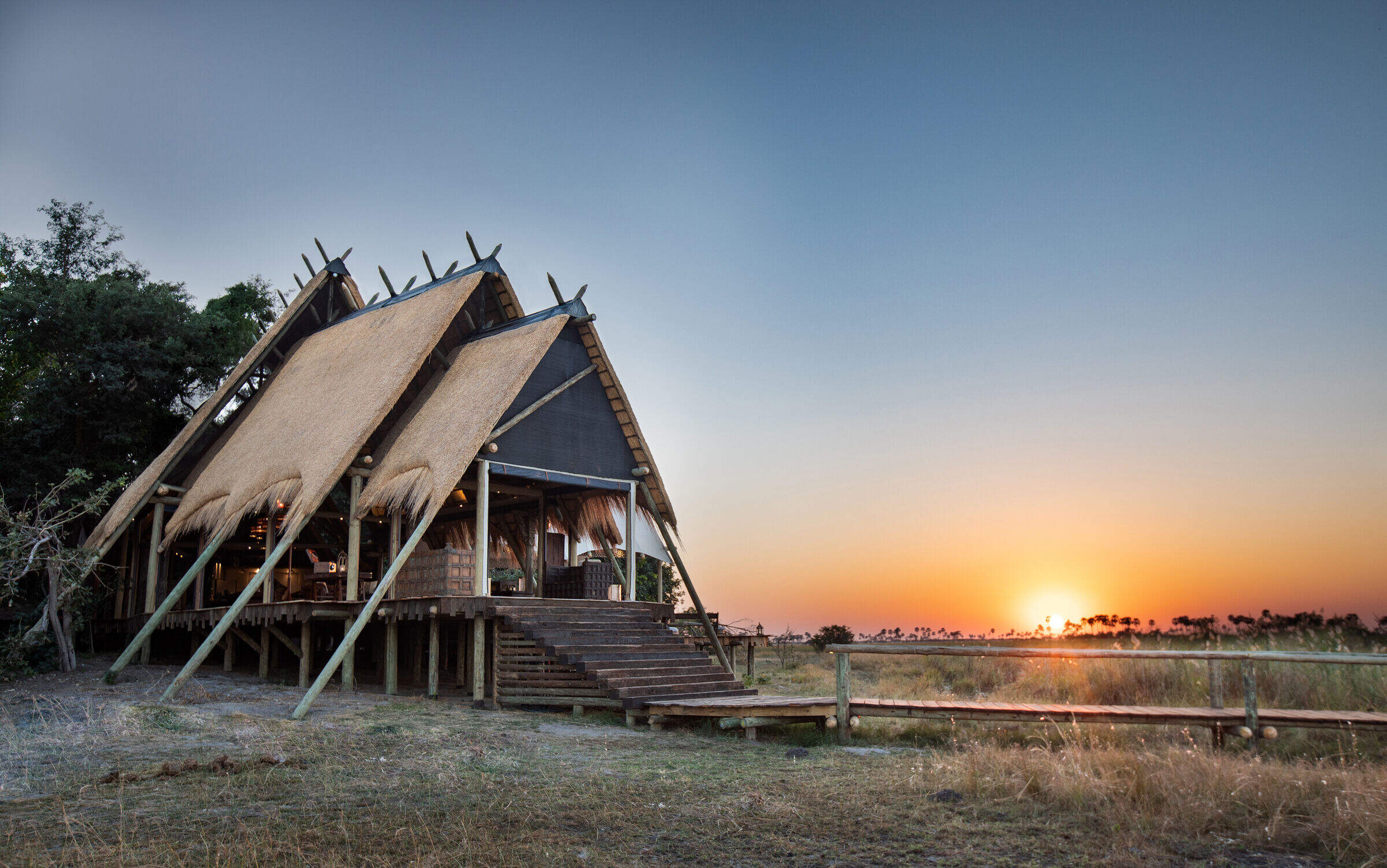
Selinda Camp
In an attractive area that is particularly rich in game between June and November, the luxurious Selinda Camp caters particularly well for photographers.
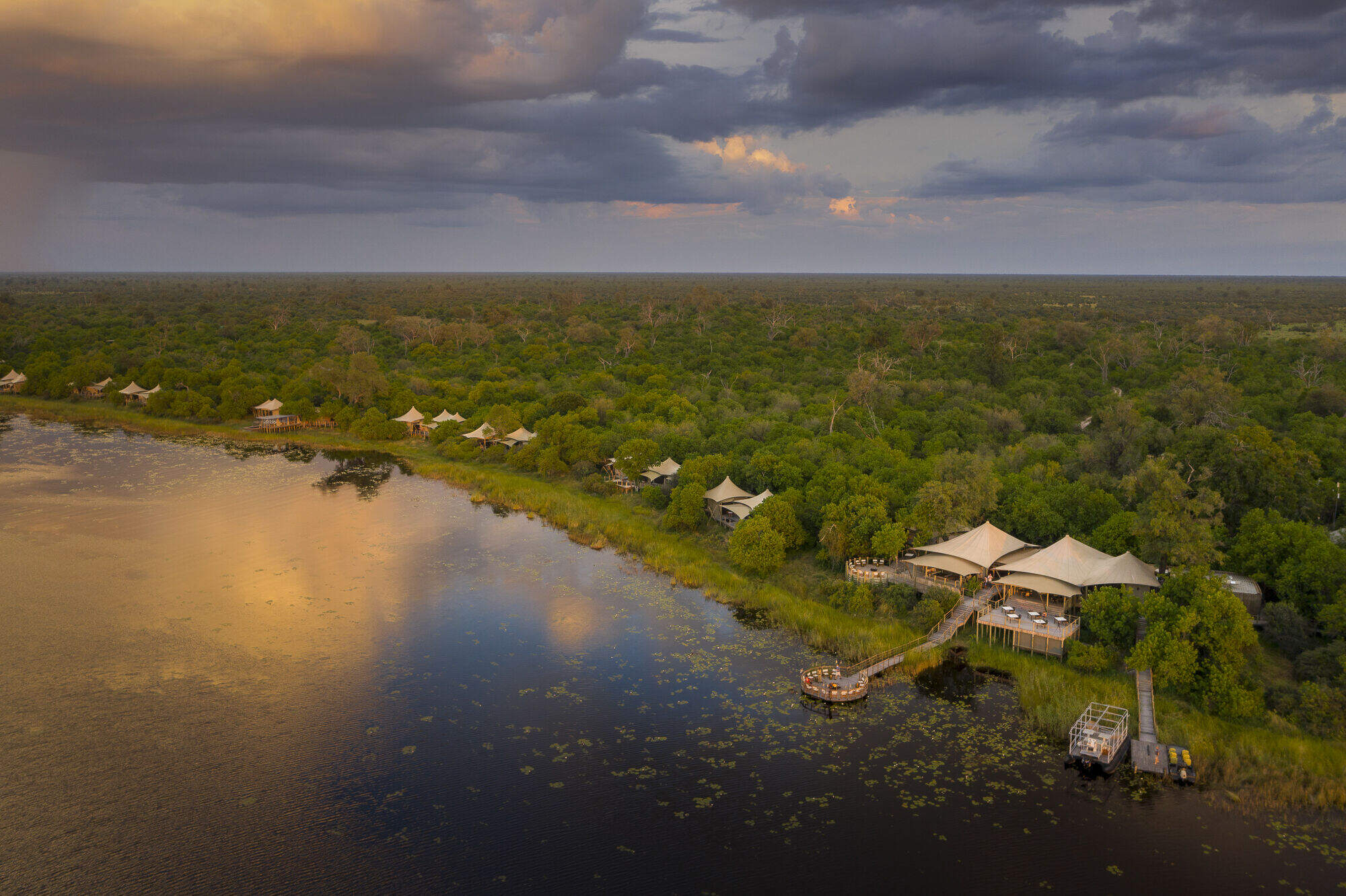
DumaTau
DumaTau, in the private Linyanti Reserve, offers game drives, seasonal boat cruises and walks. Wildlife safaris here are quite seasonal, and are at their best during the height of the dry season, between June and October.
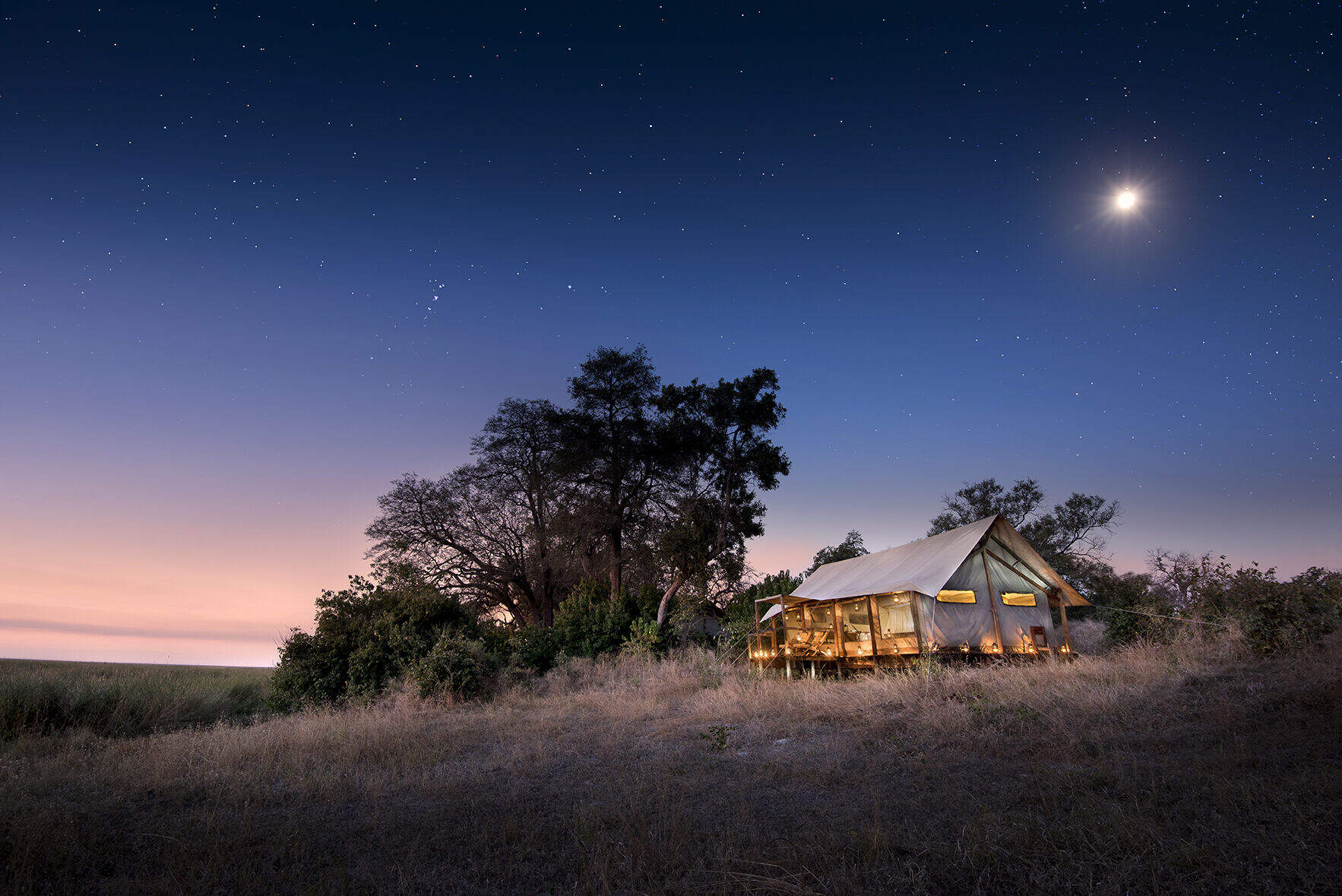
Linyanti Bush Camp
Linyanti Bush Camp blends relative simplicity with numerous activities and very good guiding.
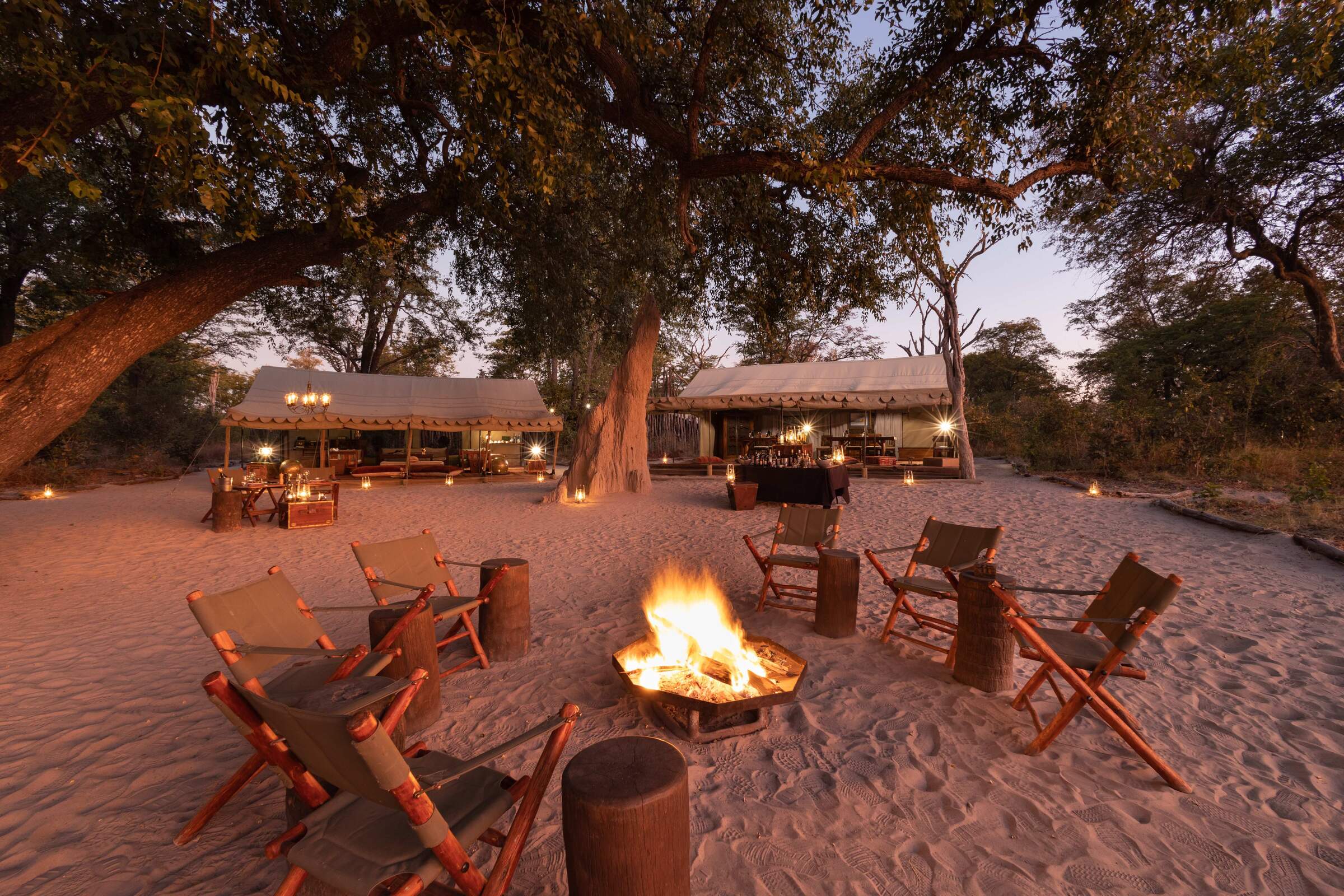
Selinda Explorers Camp
The luxurious, traditional tented Selinda Explorers Camp offers a mix of walking, canoeing and game drives led by really top notch guides in a game-rich area.
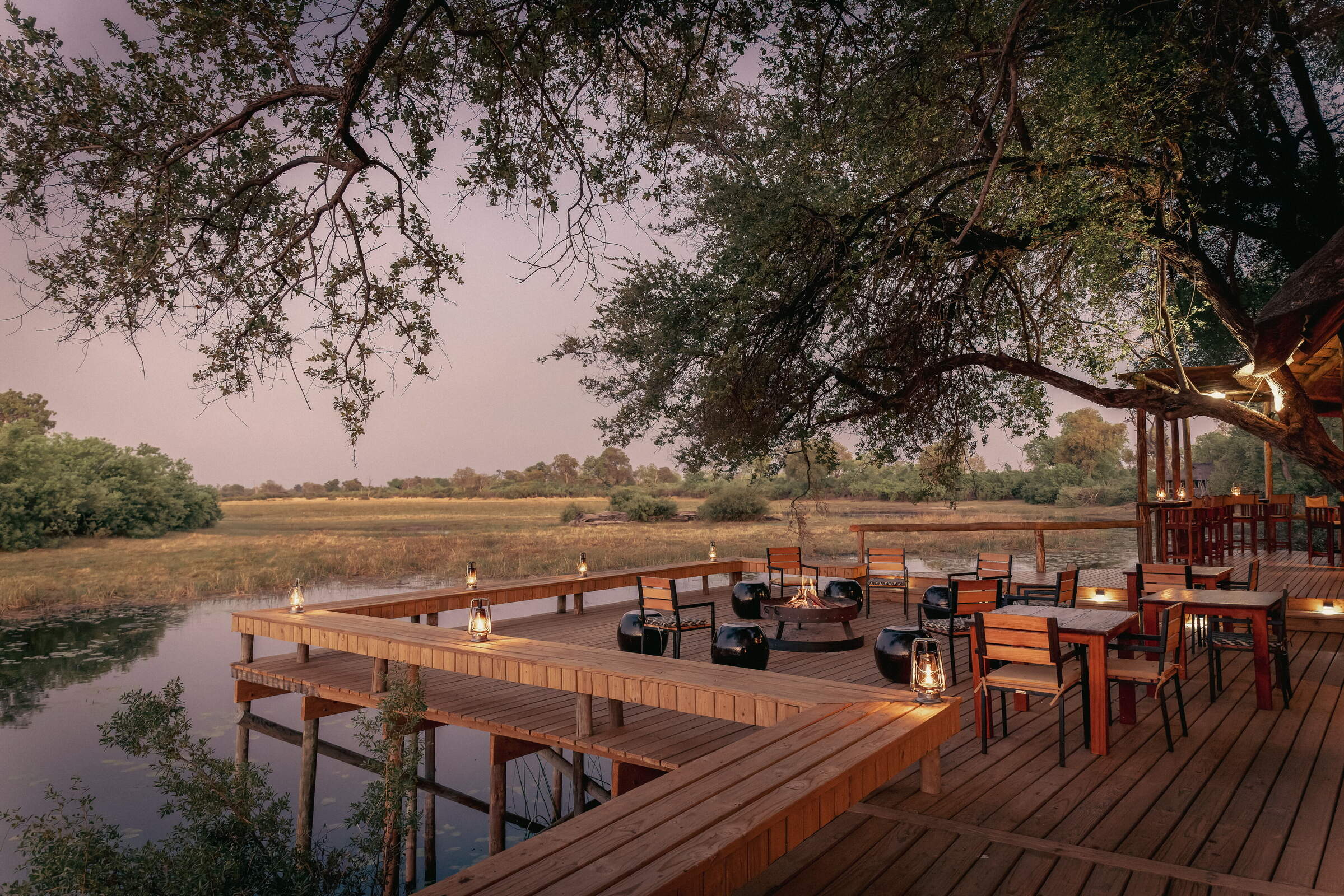
Savuti Camp
Set above the Savuti Channel, the refurbished seven-room Savuti Camp offers the potential for viewing large herds of elephant and significant lion encounters.
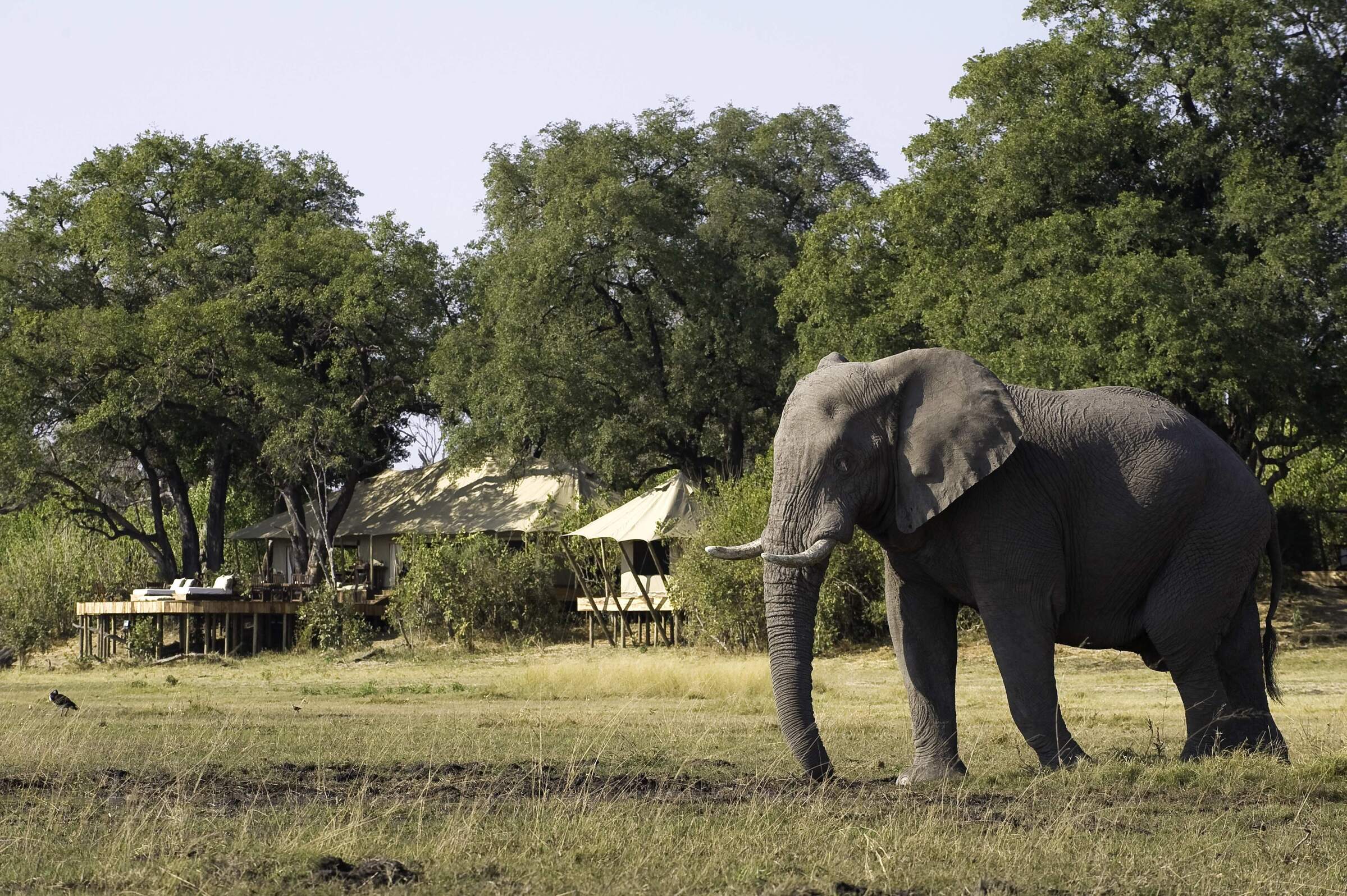
Zarafa Camp
Zarafa is an exclusive camp overlooking the scenic Zibadianja Lagoon within the Selinda Reserve, a particularly game-rich area between June and early November.
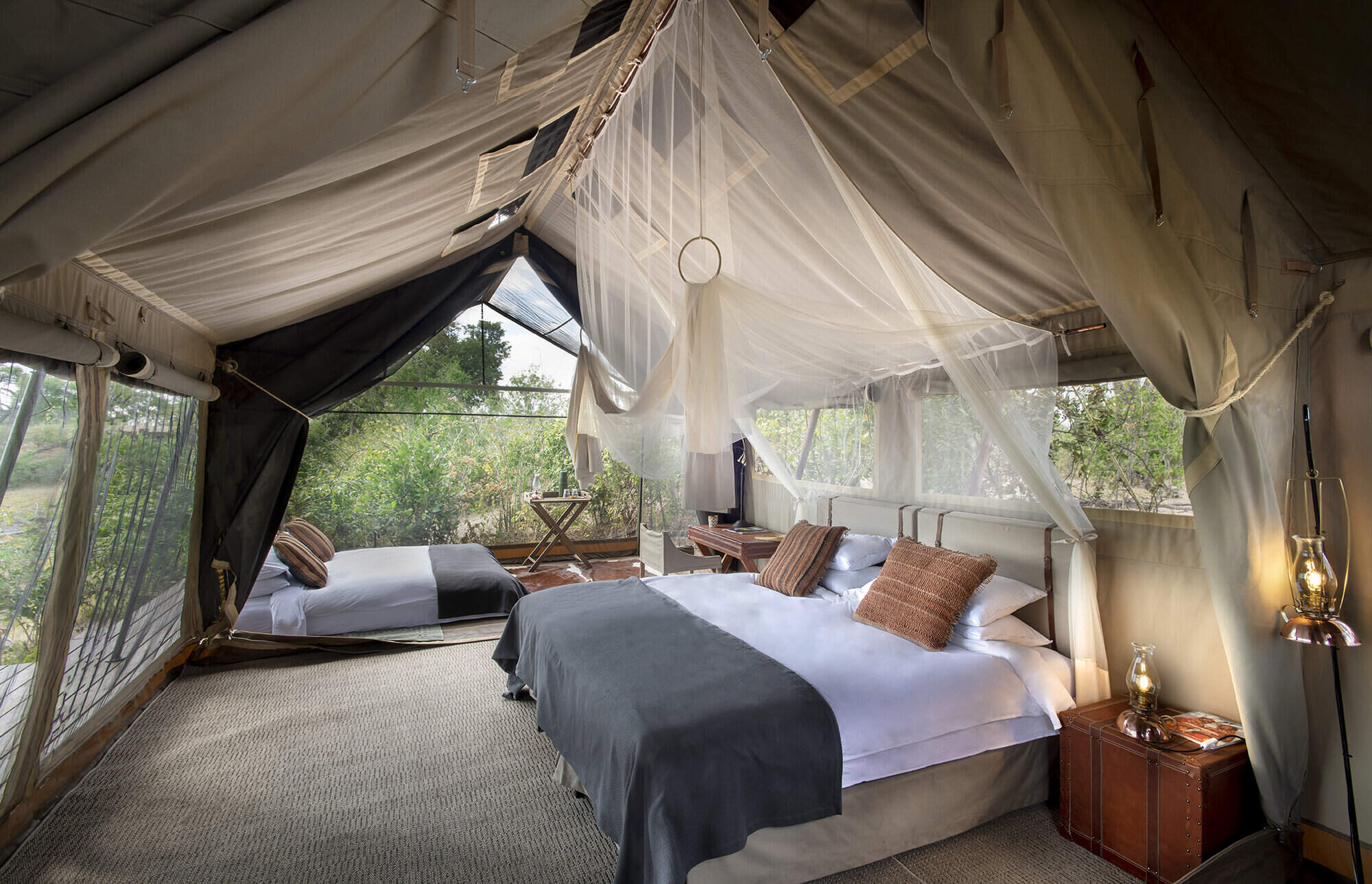
Linyanti Expeditions
Tip-top guiding. In tune with the habitat. Down-to-earth, authentic camp comfort. A place of wilderness safari harmony.
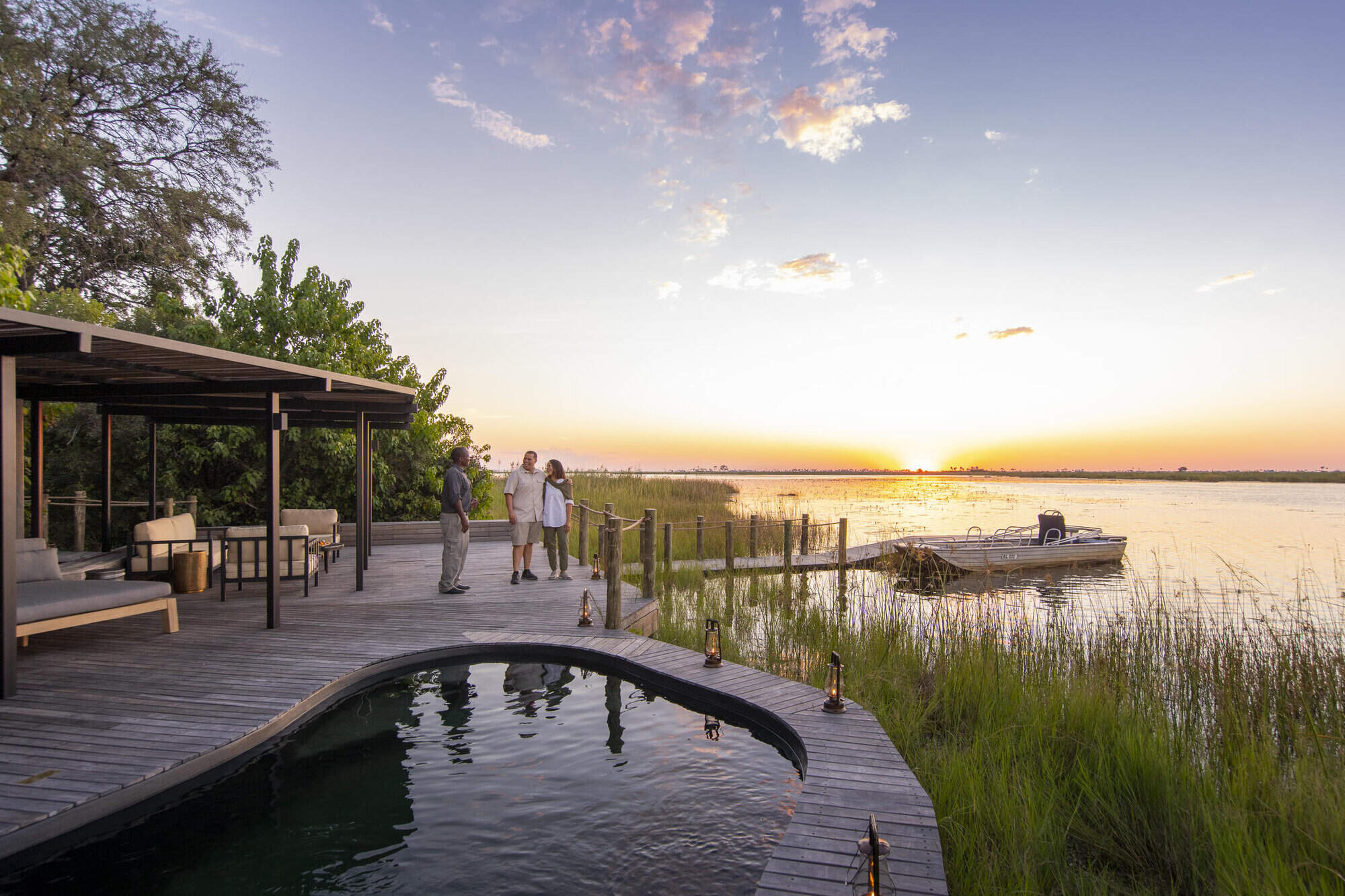
Little DumaTau
Small and sophisticated, Little DumaTau lies adjacent to its larger sibling in the private Linyanti Reserve, overlooking a beautiful lagoon.
When to go to Kwando-Linyanti area
Our month by month guide: What it's like to visit Kings Pool in Kwando-Linyanti area
Jan
Feb
Mar
Apr
May
Jun
Jul
Aug
Sep
Oct
Nov
Dec
Kwando-Linyanti area in January
January marks the peak of the rainy season in the Kwando, Linyanti, and Selinda Reserves. Evening thunderstorms bring short but intense rains, cooling the air while temperatures remain warm. Wildlife disperses across the lush landscape due to the abundant water, making game viewing more challenging, though the southern and western parts of the Selinda Reserve still offer rewarding sightings.
The Kwando River and Linyanti floodplains attract water-loving species such as red lechwe, sitatunga, and waterbuck. Migratory birds thrive during this time, offering incredible birdwatching opportunities. The vibrant greenery creates stunning photography backdrops, and lower rates make January a great choice for budget-conscious travellers seeking a quieter, greener safari.
- Warm temperatures with occasional thunderstorms
- Spectacular birdlife, including migratory species
- Wildlife dispersed across lush floodplains
- Zebra and wildebeest migration in full swing
- Good availability at lodges and camps
Our view
A good time to visit, with pros & cons
Weather in January
Kwando-Linyanti area in February
February continues the rainy season with heavy rains and a humid atmosphere. The landscape is vibrant and teeming with life. Insects and smaller animals become more visible, while many species are raising their young, making for fascinating wildlife encounters. The Selinda Spillway and Zibadianja Lagoon are magnets for diverse wildlife during this time.
Thick vegetation and tall grasses can make it harder to spot larger animals, but water-based activities like boat cruises along the Kwando and Linyanti rivers offer superb birdwatching. The reserves’ papyrus reed-beds are home to elusive species like sitatunga, while buffalo and elephants frequent the floodplains. With fewer visitors, February is perfect for those looking for a more intimate safari experience.
- Warm with occasional thunderstorms
- Young animals abundant across the reserves
- Dispersed wildlife across the lush terrain
- Birds thriving, many in breeding plumage
- Excellent camp availability and low visitor numbers
Our view
This is not a great time to visit
Weather in February
Kwando-Linyanti area in March
March marks the tail end of the rainy season, with sunny days becoming more frequent and occasional afternoon thunderstorms still sweeping through. The landscape remains lush, with many animals finishing raising their young. Predators like lions and wild dogs are more active, taking advantage of plentiful prey.
Birdwatching is still rewarding, although some migratory species start to leave as the season progresses. The Kwando River and its channels provide excellent fishing and wildlife viewing opportunities. As the rains taper off, game drives become more productive, particularly in open areas of the reserves.
- Variable weather with clearer skies and rains decreasing
- Wildlife well-fed and thriving in lush surroundings
- Birdlife remains spectacular, though migrants begin to leave
- Lower rates and fewer visitors at camps
Our view
A good time to visit, with pros & cons
Weather in March
Kwando-Linyanti area in April
April is a transitional month in the Kwando, Linyanti, and Selinda Reserves, marking the shift from the wet to dry season. Rainfall becomes less frequent, giving way to clear skies and a verdant landscape. Night temperatures start to drop, especially in areas further from water.
As vegetation begins to thin, wildlife viewing improves, with increased predator-prey activity around water sources. The Selinda Spillway becomes a focal point for diverse wildlife, including elephants, buffalo, and various antelope species. Predator activity starts to become more visible, particularly around permanent water sources. Walking safaris and boat cruises offer unique ways to explore the ecosystem. With the shoulder season starting, April provides good value and a mix of lush scenery and growing wildlife activity.
- Cooler evenings with occasional light rain
- Selinda Spillway ideal for diverse wildlife sightings
- Good predator-prey interactions observable
- Excellent conditions for walking safaris and boat trips
- Shoulder season rates make this a popular month
Our view
A good time to visit, with pros & cons
Weather in April
Kwando-Linyanti area in May
May is one of the best months to visit the Kwando, Linyanti, and Selinda Reserves. With almost no rain, temperatures cool further in the mornings and evenings, increasing predator activity. Wildlife begins to concentrate around permanent water sources like the Linyanti and Kwando rivers, providing superb game viewing opportunities, especially of elephants and buffalo.
The Selinda Reserve’s diverse landscapes attract a variety of species, and walking safaris in the Kwando Reserve provide close-up wildlife encounters. Crisp, clear air enhances photography, capturing the vibrant wildlife and scenic beauty. May offers a balance of fantastic wildlife sightings, pleasant weather, and the final stretch of shoulder-season rates.
- Cool mornings and evenings, minimal rain
- Excellent predator activity and game viewing
- Crisp air perfect for photography
- Shoulder season rates - availability limited
Our view
A very good time to visit
Weather in May
Kwando-Linyanti area in June
June signals the start of the dry season, with cool mornings and evenings and warm, sunny days. The clear skies and thinning vegetation make this an excellent month for photography and wildlife viewing. As surface water dries up, animals gravitate to permanent water sources like the Kwando and Linyanti rivers, where predators are often seen stalking prey.
Game viewing excels in the Kwando-Linyanti areas, with improved visibility as vegetation thins, and the Selinda Spillway becomes a wildlife hotspot, attracting elephants, buffalo, and other species. Boat cruises provide a peaceful way to observe water-dependent wildlife, while night drives offer glimpses of nocturnal predators and other species. June’s popularity means high demand for camps, so early bookings are essential.
- Warm days, cold nights—ideal safari conditions
- Excellent conditions for wildlife photography
- Animals congregating around water sources
- Vegetation thinning, improving visibility
- Peak season begins with higher rates
Our view
Fantastic: the very best time to visit
Weather in June
Kwando-Linyanti area in July
July offers excellent game viewing conditions. Cool mornings and evenings are ideal for wildlife activity. The landscape is drier, concentrating animals around remaining water sources. The Kwando and Linyanti rivers become crucial for wildlife, attracting large herds of elephants and buffalo. Predator sightings increase, especially around waterholes. The Selinda Reserve's diverse habitats support a wide range of species, from big cats to rare antelopes.
It's one of the best months for walking safaris - cool and fresh in the mornings, with thinning vegetation enhancing visibility. Boat cruises provide serene views of the rivers and their surrounding wildlife. Night drives reveal fascinating nocturnal species, though temperatures can be chilly, so warm clothing is essential. July's popularity means camps are often fully booked, so early reservations are essential.
- Comfortable days, cold mornings and nights
- Excellent game viewing around waterholes and rivers
- Walking safaris and boat cruises highly recommended
- Peak season with camps often fully booked
Our view
Fantastic: the very best time to visit
Weather in July
Kwando-Linyanti area in August
August is a peak safari month, with warm days and cool nights offering comfortable conditions. Wildlife is highly concentrated around water sources, providing exceptional game viewing. The Selinda Spillway becomes a focal point for predators and prey, with frequent sightings of elephants, buffalo, and big cats.
Boat cruises along the Kwando and Linyanti rivers offer a unique perspective on the reserves’ wildlife, while clear skies make for incredible stargazing at night – but it’s cold so bring warm clothes, hats and gloves. August's popularity for northern hemisphere travellers means limited availability and higher rates at most camps.
- Dry, warm days with cool nights
- Wildlife activity peaks around water sources
- Okavango floods usually reach Selinda Spillway
- Super stargazing on clear nights
- High rates and limited availability in camps
Our view
Fantastic: the very best time to visit
Weather in August
Kwando-Linyanti area in September
September is a favourite for wildlife enthusiasts, with probably the best wildlife viewing of the year. Daytime temperatures are warming, but nights remain cool. The dry landscape concentrates wildlife around permanent water sources like the Kwando and Linyanti rivers, and along the Selinda Spillway. Large herds of elephants and buffalo are common on the floodplains, and predator sightings increase, with higher chances of witnessing dramatic hunting interactions.
The return of migratory birds like carmine bee-eaters adds a splash of colour to the reserves, enhancing birdwatching. The dry, hazy conditions create dramatic sunsets, while boat cruises and game drives offer rewarding, laid-back wildlife encounters. September’s popularity means high rates and limited availability at most camps, with early booking is essential.
- Warm days, cool nights—prime safari weather
- Exceptional wildlife viewing and predator activity
- Stunning sunsets and excellent birdwatching
- High season continues with limited availability
Our view
Fantastic: the very best time to visit
Weather in September
Kwando-Linyanti area in October
October is the hottest and driest month in these reserves, creating some of the most concentrated and dramatic wildlife sightings of the year. Animals gather around dwindling water sources, leading to intense predator-prey interactions. The Selinda Spillway becomes a lifeline for both herbivores and carnivores.
Boat cruises offer relief from the heat and a chance to observe water-dependent species. Migratory birds continue to arrive, adding vibrancy to the parched landscape. The clear, hazy conditions create spectacular photographic opportunities, particularly at sunset. Night drives are not nearly so cold and can reveal fascinating nocturnal activities. Despite the daytime heat, October remains a favourite for game viewing.
- Hot days, with chances of rain late in the month
- Outstanding big game sightings around limited water sources
- Excellent birdwatching with arriving migrants
- Water activities limited as floods recede
- Final month of peak season - high demand at camps
Our view
Fantastic: the very best time to visit
Weather in October
Kwando-Linyanti area in November
Sometime in November usually marks the start of the green season as temperatures and humidity rise, leading to the first dramatic thunderstorms. The landscape begins to transform, with fresh greenery spreading across the reserves. Wildlife starts to disperse as waterholes refill, but predator sightings remain good near permanent water sources. The Kwando and Linyanti rivers remain important for the large herds of elephants, and the Selinda Spillway continues to attract wildlife.
This is a fantastic time for birdwatching, with migratory species arriving in abundance. Where available, boat cruises highlight the changing environment, while game drives still offer rewarding wildlife encounters. Early November sees lower rates, making it a good choice for travellers seeking great game viewing at lower rates.
- Hot days with increasing humidity and dramatic thunderstorms
- Green season begins transforming landscape
- Wildlife viewing less predictable but rewarding near rivers
- Migratory birds arrive, enhancing birdwatching
- Shoulder season offers lower rates and good availability
Our view
A good time to visit, with pros & cons
Weather in November
Kwando-Linyanti area in December
December marks the height of the rainy season, bringing welcome relief from the high temperatures. While wildlife viewing becomes more challenging due to the dispersal of animals, skilled guides can still uncover remarkable sightings. The Kwando and Linyanti rivers remain vital habitats, and areas such as the Selinda Reserve offer rewarding game viewing, especially around Zibadianja Lagoon.
The landscape undergoes a dramatic transformation as fresh growth attracts herbivores. Migratory birds are plentiful, making this an excellent time for birdwatching. Although predator sightings are less frequent, they are often spectacular against the vibrant, lush scenery. Luxurious camps offer comfortable retreats during occasional rain showers, and lower-season rates make December an appealing choice for value-conscious travellers seeking a green-season safari.
- Warm with frequent rain storms
- Wildlife more dispersed across the reserves
- Green season in full effect, lush landscapes
- Low season rates make it a value-friendly option
Our view
A good time to visit, with pros & cons
Weather in December

Looking for inspiration on where to travel next?
Visit our trip chooser to explore your options and find inspiration for your perfect African adventure
Inspire me